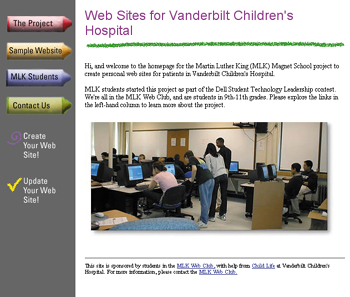
Martin Luther King students designed the templates to allow patients at Vanderbilt Children’s Hospital to easily create personal Web sites.
Local students link patients to the Web

When Gill Murrey, Vanderbilt-Ingram Cancer Center Web designer, volunteered to sponsor the computer club at her son’s school, she had no idea that she would have the opportunity to realize an idea that she and others had for several years: provide Vanderbilt Children’s Hospital patients a way to contact friends and family via the Internet.
Through a project sponsored by Dell Computers, students in the Computer Club at the Martin Luther King Magnet School were challenged to design and develop a project that would benefit the community. The Dell Student Technology Leadership Teams (STL) is a collaboration among local universities, Dell, Metropolitan Nashville Schools, and Wilson County Schools that will organize student technology teams at high schools and middle schools. Each team will create a technology project. At the end of the year, the team with the best project will win a Dell Wireless Laptop Lab for their school.
“So, our idea was to create personal Web sites for patients of the Children’s Hospital,” explained Murrey.
Before development began, Murrey asked Angie Paulk, Child Life specialist and technology expert, to meet with the MLK students to give them additional guidance. Murrey and Paulk had both been members of a committee called “Computers for Kids,” an initiative to give VCH patients something to do while in the hospital. The result was the new bedside computer program that provides pediatric patients with computers in their rooms.
With her experience, Paulk was able to provide valuable input in the initial design phase. She knew that the technical expertise of the average VCH patient would vary considerably and that the process to create the sites would have to be clear and easy to understand.
Following the design meeting, the students began surfing the Web for design ideas and developed templates from which the patients could choose. Template styles include sports, animals, babies, and even ballet themes. Patients simply select a theme and the pages to be included. They are then given a secure form that can be completed online, allowing them to develop their own content. Paulk walks the patients, or their parents, through the form.
Although the Web sites are available to all pediatric patients, at this point in the two-week-old program, Paulk relies on her fellow Child Life specialists to identify patients who would benefit from the sites. The ideal candidates have been in the hospital for an extended period and are well enough to seek activities to keep their minds occupied. Creating their own personal Web site and maintaining it can be a welcome distraction from television or video games.
One of most attractive aspects to this program is its cost: nothing. The MLK students developed the application. Monster Labs/Moses.com donated hosting for the sites.
Murrey and Paulk would like to see this program eventually extend to all areas of VUMC, not just Children’s Hospital. Many patients, such as those at the cancer center, are away from home for long periods. Offering Web sites, especially those with features such as message boards, could offer patients a feeling of community connection that can be lost as the patient battles a disease.
“Hopefully, this project will become a pilot program that can be expanded,” said Murrey. “We’d like to take the program hospital-wide.”













